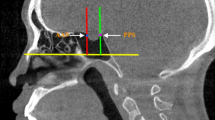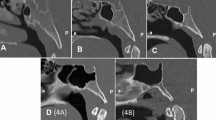Abstract
In the present study, we investigated whether there is a relationship between sphenoid sinus (SS) types, septation (lobulation) and symmetry; and septal deviation (SD) by multidetector computed tomography (MDCT). Paranasal MDCT images of 202 subjects (131 males, 71 females), between 10- and 88-year-old, were included into the study. SS type (conchal, presellar or sellar), SS symmetry, SS septation (lobulation) and SD were evaluated by MDCT images. In the present study, in both males (83.2 %) and females (85.9 %); and in all age groups (80.4–85.7 %), sellar type sphenoid sinus were more detected. Conchal type was detected in two cases of the males (1.5 %) and none of the females. SS was detected mainly as multi-septated (multi-lobulated) (51.9 % in males and 56.3 % in females; in all age groups as 51.0–56.8 %; and both SD (+) and SD (−) groups as 51.2–56.8 %). In subjects with SD, asymmetric SS was detected in 80.2 %. Whereas in SD (−) subjects, asymmetric SS was detected in 50.6 %. Sellar type SS pneumatization is the most detected type in our cases. Presence of SD was related to the higher SS asymmetry values. In SD (−) subjects, SS was detected as symmetric. Nasal septal deformities such as SD may influence the development of the SS pneumatization and asymmetric septation. For well anatomic orientation of the surgeons, good anatomy knowledge and preoperative detailed examination of the CT scans are very important.







Similar content being viewed by others
References
Wang J, Bidari S, Inoue K, Rhoton A Jr (2010) Extensions of the sphenoid sinus: a new classification. Neurosurgery 66:797–816
Hamberger CA, Hammer G, Norlen G (1961) Transphenoidal hypophysectomy. Arch Otolaryngol 1961(74):2–8
Štoković N, Trkulja V, Dumić-Čule I, Čuković-Bagić I, Lauc T, Vukičević S et al (2016) Sphenoid sinus types, dimensions and relationship with surrounding structures. Ann Anat 203:69–76
Farajoli B, Esposito V, Santoro A et al (1995) Transmaxillo-sphenoidal approach to tumors invading the medial compartment of the cavernous sinus. J Neurosurg 82(1):63–69
Elwany S, Yacourt YM, Talaat M et al (1983) Surgical anatomy of the sphenoid sinus. J Laryngol Otol 97:227–241
Filho BC, Pinheiro-Neto CD, Weber R, Voegels RL (2008) Sphenoid sinus symmetry and differences between sexes. Rhinology 46(3):195–199
Koch B, Castillo M (2010) Sinonasal diseases. In: Rossi A (ed) Pediatric neuroradiology. Springer, Berlin Heidelberg, pp 1391–418
Javadrashid R, Naderpour M, Asghari S, Fouladi DF, Ghojazadeh M (2014) Concha bullosa, nasal septal deviation and paranasal sinusitis; a computed tomographic evaluation. B-ENT 10(4):291–298
Unal B, Bademci G, Bilgili YK, Batay F, Avci E (2006) Risky anatomic variations of sphenoid sinus for surgery. Surg Radiol Anat 28(2):195–201
Wang J, Bidari S, Inoue K, Yang H, Rhoton A Jr (2010) Extensions of the sphenoid sinus: a new classification. Neurosurgery 66(4):797–816
Budu V, Mogoantă CA, Fănuţă B, Bulescu I (2013) The anatomical relations of the sphenoid sinus and their implications in sphenoid endoscopic surgery. Rom J Morphol Embryol 54(1):13–16
Levine HL, Clemente MP (2005) Sinus surgery: endoscopic and microscopic approaches. Thieme, New York, pp 6–12
Williams PL, Warwick R, Dyson M, Bannister LH (eds) (1995) Gray’s anatomy, 38th edn. Churchill Livingstone, Edinburgh, pp 585–589
ELKammash TH, Enaba MM, Awadalla AM (2014) Variability in sphenoid sinus pneumatization and its impact upon reduction of complications following sellar region surgeries. Egypt J Radiol Nucl Med 45:705–714
Romano A, Zuccarello M, Van Loveren HR, Keller JT (2001) Expanding the boundaries of the trans-sphenoidal approach: a micro anatomic study. Clin Anat 14:1–9
Mason RB, Nieman LK, Doppman JL, Oldfield EH (1997) Selective excision of adenomas originating in or extending into the pituitary stalk with preservation of the pituitary function. J Neurosurg 87(3):343–351
Fatemi N, Dusick JR, de Paiva Neto MA, Kelly DF (2008) The endonasal microscopic approach for pituitary adenomas and other parasellar tumors: a 10-year experience. Neurosurgery 63(4 Suppl 2):244–256
Sirikci A, Bayazzit YA, Mumbuc S et al (2000) Variations of the sphenoid and related structures. Euro Radiol 10(5):844–848
Hosemann WG, Weber RK, Keerl RE et al (2000) Minimally invasive endonasal sinus surgery. Principles, techniques, results, complications, revision surgery. Thieme, New York
Locatelli M, Caroli M, Pluderi M et al (2011) Endoscopic transsphenoidal optic nerve decompression: an anatomical study. Surg Radiol Anat 33(3):257–262
Gupta T, Aggarwal A, Sahni D (2013) Anatomical landmarks for locating the sphenoid ostium during endoscopic endonasal approach: a cadaveric study. Surg Radiol Anat 35(2):137–142
Sethi DS, Leong JL (2006) Endoscopic pituitary surgery. Otolaryngol Clin North Am 39:563–583
Zhang Y, Wang Z, Liu Y et al (2008) Endoscopic transsphenoidal treatment of pituitary adenomas. Neurol Res 30:581–586
Fulcheri E, di Capua E, Ragni N (2003) Pregnancy despite IUD: adverse effects on pregnancy evolution and fetus. Contraception 68(1):35–38
Kvinnsland S (1970) The relationship between the cartilaginous nasal septum and maxillary growth during human fetal life. Cleft Palate J 7:523–532
Ruano-gil D, Montserrat-Viladiu JM, Vilanova-trias J, Burges-Vila J (1980) Deformities of the nasal septum in human foetuses. Rhinology 18:105–109
Poorey VK, Gupta N (2014) Endoscopic and computed tomographic evaluation of influence of nasal septal deviation on lateral wall of nose and its relation to sinus diseases. Indian J Otolaryngol Head Neck Surg 66(3):330–335
Elahi MM, Frenkiel S, Fageeh N (1997) Paraseptal structural changes and chronic sinus disease in relation to the deviated septum. J Otolaryngol 26(4):236–240
Teul I, Slawinski G, Lewandowski J, Dzieciolowska-Baran E, Gawlikowska-Sroka A, Czerwinski F (2010) Nasal septum morphology in human fetuses in computed tomography images. Eur J Med Res 15 Suppl 2:202–205
Başak S, Karaman CZ, Akdilli A, Mutlu C, Odabaşi O, Erpek G (1998) Evaluation of some important anatomical variations and dangerous areas of the paranasal sinuses by CT for safer endonasal surgery. Rhinology 36(4):162–167
Al-Abri R, Bhargava D, Al-Bassam W, Al-Badaai Y, Sawhney S (2014) Clinically significant anatomical variants of the paranasal sinuses. Oman Med J 29(2):110–113
Citardi MJ, Gallivan RP, Batra PS, Maurer CR Jr, Rohlfing T, Roh HJ et al (2004) Quantitative computer-aided computed tomography analysis of sphenoid sinus anatomical relationships. Am J Rhinol 18(3):173–178
Author information
Authors and Affiliations
Corresponding author
Ethics declarations
Conflict of interest
Mehmet Hüseyin Akgül declares that he has no conflict of interest. Nuray Bayar Muluk declares that she has no conflict of interest. Veysel Burulday declares that he has no conflict of interest. Ahmet Kaya declares that he has no conflict of interest.
Ethical approval
Local Ethics Committee of Kırıkkale University Faculty of Medicine was taken (Date: 10.11.2015, No: 2015-25/04).
Informed consent
This study is retrospective. Ethics committee approval was obtained. There is no need to take informed consent, because the data was evaluated retrospectively.
Funding
There is no funding source for this manuscript.
Rights and permissions
About this article
Cite this article
Akgül, M.H., Muluk, N.B., Burulday, V. et al. Is there a relationship between sphenoid sinus types, septation and symmetry; and septal deviation?. Eur Arch Otorhinolaryngol 273, 4321–4328 (2016). https://doi.org/10.1007/s00405-016-4138-7
Received:
Accepted:
Published:
Issue Date:
DOI: https://doi.org/10.1007/s00405-016-4138-7




